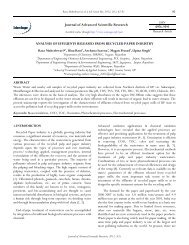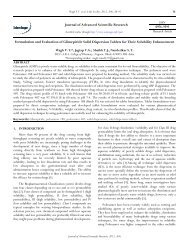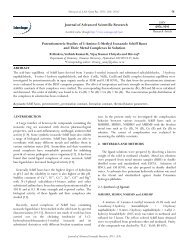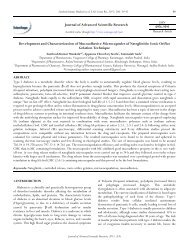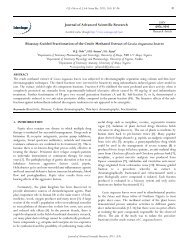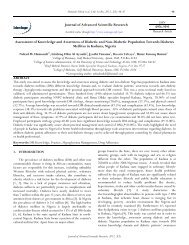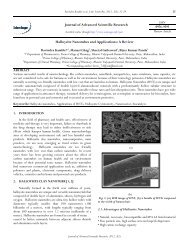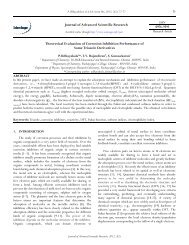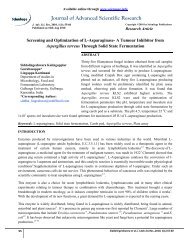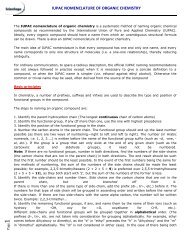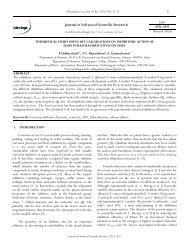Density Functional Theory Investigations for the ... - Sciensage.info
Density Functional Theory Investigations for the ... - Sciensage.info
Density Functional Theory Investigations for the ... - Sciensage.info
Create successful ePaper yourself
Turn your PDF publications into a flip-book with our unique Google optimized e-Paper software.
M Lebrini et al. have studied <strong>the</strong> inhibiting effects of some<br />
oxadiazole derivatives on <strong>the</strong> corrosion of mild steel in<br />
perchloric acid solution [21]. Joseph Raj et al. have investigated<br />
<strong>the</strong> effect of some oxadiazole derivatives on <strong>the</strong> corrosion<br />
inhibition of brass in natural seawater [22]. A new class of<br />
corrosion inhibitors of mild steel in acidic media on <strong>the</strong><br />
substituted 1,3,4-oxadiazoles was studied by bentiss et al. [23].<br />
Although experimental work of M. Benabdellah, et al. [24]<br />
provide valuable in<strong>for</strong>mation on <strong>the</strong> corrosion inhibition<br />
efficiency of 2,5-Bis(4-methylphenyl)-1,3,4-oxadiazole (Inh-I)<br />
and 2,5-bis(4-methoxyphenyl)-1,3,4-oxadiazole (Inh-II), a<br />
deep understanding of <strong>the</strong> inhibition property remain unclear.<br />
To date, however, no study has been per<strong>for</strong>med to investigate<br />
<strong>the</strong> corrosion inhibition efficiency of Inh-II >Inh-I by using<br />
quantum chemical calculations. The aim of <strong>the</strong> present work is<br />
to correlate <strong>the</strong> clear relationship between <strong>the</strong> experimentally<br />
determined inhibition efficiencies with <strong>the</strong> quantum chemical<br />
parameters of <strong>the</strong> investigated inhibitors.<br />
The analyzed inhibitive properties are <strong>the</strong> molecular<br />
structure, <strong>the</strong> dipole moment, E HOMO , E LUMO , energy gap (ΔE),<br />
and those parameters that give valuable in<strong>for</strong>mation about <strong>the</strong><br />
reactive behavior: electronegativity (χ), global hardness (η)<br />
and <strong>the</strong> fraction of electrons transferred from <strong>the</strong> inhibitor<br />
molecule to <strong>the</strong> metallic atom (ΔN) and <strong>the</strong> back-donation<br />
(ΔE Back-donation ). The local reactivity has been analyzed by means<br />
of <strong>the</strong> Fukui indices, since <strong>the</strong>y indicate <strong>the</strong> reactive regions, in<br />
<strong>the</strong> <strong>for</strong>m of <strong>the</strong> nucleophilic and electrophilic behavior of each<br />
atom in <strong>the</strong> molecule. Results obtained showed that <strong>the</strong><br />
inhibition efficiency of Inh-II > Inh-1. It is well correlated with<br />
<strong>the</strong> experimental results. From <strong>the</strong> calculations we have<br />
explained which adsorption site is favoured to bind to <strong>the</strong><br />
metal surface.<br />
2. MATERIAL AND METHODS<br />
2.1. Quantum-chemical calculation<br />
P. Udhayakala et al, J Adv Sci Res, 2012, 3(3): 67-74 68<br />
is considered a very useful technique to probe <strong>the</strong><br />
inhibitor/surface interaction as well as to analyze <strong>the</strong><br />
experimental data. The results of <strong>the</strong> geometry optimization of<br />
<strong>the</strong> compounds Inh-I and Inh-II are presented in Figure 1.<br />
2,5-bis(4-methylphenyl)-1,3,4-oxadiazole (Inh-I)<br />
2,5-bis(4-methoxyphenyl)-1,3,4-oxadiazole (Inh-II)<br />
Inh-I<br />
Among quantum chemical methods <strong>for</strong> evaluation of<br />
corrosion inhibitors, density functional <strong>the</strong>ory (DFT) has<br />
shown significant promise and appears to be adequate <strong>for</strong><br />
pointing out <strong>the</strong> changes in electronic structure responsible <strong>for</strong><br />
inhibitory action [25]. In order to explore <strong>the</strong> <strong>the</strong>oreticalexperimental<br />
consistency, quantum chemical calculations were<br />
per<strong>for</strong>med with complete geometry optimizations using<br />
standard Gaussian-03 software package [26]. Geometry<br />
optimization were carried out by B3LYP functional at <strong>the</strong> 6-<br />
31G (d,p) basis set [27]. This basis set provided accurate<br />
geometry and electronic properties of a wide range of organic<br />
compounds [28]. Recently, <strong>Density</strong> functional <strong>the</strong>ory (DFT)<br />
has been used to analyze <strong>the</strong> characteristics of <strong>the</strong> inhibitor/<br />
surface mechanism and to describe <strong>the</strong> structural nature of <strong>the</strong><br />
inhibitor in <strong>the</strong> corrosion process [29, 30]. Fur<strong>the</strong>rmore, DFT<br />
Inh-II<br />
Figure 1. Optimized molecular structure of Inh-I and Inh-II by<br />
B3LYP/6-31G (d,p)<br />
<strong>Density</strong> functional <strong>the</strong>ory (DFT) has become an attractive<br />
<strong>the</strong>oretical method because it gives exact basic vital parameters<br />
<strong>for</strong> even huge complex molecules at low cost [31, 32]. It has<br />
been quite successful in providing <strong>the</strong>oretical basis <strong>for</strong> popular<br />
qualitative chemical concepts like electronegativity (χ),<br />
Journal of Advanced Scientific Research, 2012, 3(3)



